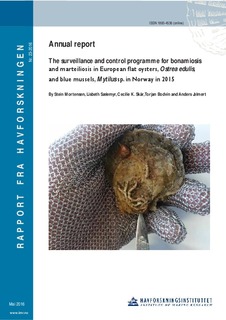| dc.description.abstract | Bonamia ostreae/B. exitiosa or Marteilia sp.was not detected during the surveillance
programme in 2015.
The programme was revised in 2015: We selected four wild beds and one oyster farm, based
on the present distribution of wild flat oyster beds, and the structure of the (very limited
Norwegian) oyster industry. Samples were collected in april/may and in October, in order to
be able to detect Bonamia sp. and Marteilia sp. during the periods when the potential
prevalence could be at the highest.
No abnormal mortalities were observed during the surveillance. In oysters, cells resembling
“microcells” were observed as previously, with an approximate prevalence of 10 % in the
spring samples from Langestrand, and 50 % in the spring samples from Hui, with a very low
intensity, and as individual cells. No inflammation or pathological alterations were observed,
and the oysters appeared in good health. A Bonamia specific Real-time PCR was performed
on all 150 specimens from Langestrand in the spring and 16 specimens from Hui where
“microcells” were observed in the spring sample. Microcytos specific Real-time PCR and
nested PCR were performed on the 16 oysters from Hui, and 18 oysters from Langestrand,
where the microcells were observed in the spring sampling. All samples were negative with
both assays, and the observed cells are therefore not interpreted as Bonamia sp. or Microcytos
sp. One additional mussel sample was included, after a report of abnormal mortalities in
several mussel farms in Åfjorden, Trøndelag. No pathogens or pathological alterations were
observed.
Very few flat oysters were observed at Hui in Vestfold, indicating that the populations in this
area are low. We recommend excluding this site in 2016, and instead include the oyster spat
producer at Aga, Bømlo. This will give a better overview of the producers and a control of
spat that are distributed to the farms that are still in operation. | nb_NO |
